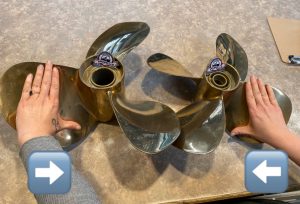HOW DO YOU READ PROPELLER DIMENSIONS?
Most propellers will have measurements stamped between the blades, or around the hub on the aft end.
Let’s look at this example:
14-1/2 X 19 RH 3 Blade SS Apollo Propeller
We’ll break it down by section:
14-1/2 : The propeller diameter. The diameter is always the first set of numbers.
19: The pitch of the propeller. The pitch is always the second set of numbers.
RH: This is the propeller’s rotation. Either RH clockwise or LH counterclockwise.
3 Blade: This is the number of blades. It can be 2, 3, 4, or 5 blades.
SS : This represents the propeller material. AL = Aluminum & SS = Stainless Steel.
An inboard will be either Bronze or Nibral, older inboards may also be Stainless Steel.
Apollo Propeller: This is the style or brand of the propeller. You may see a name, but not always.
What’s the difference between propeller diameter and pitch?
The diameter of a propeller is two times the distance from the center of the hub to the tip of the blade. It also can be looked at as the distance across the circle that the propeller would make when rotating. The propeller’s diameter is the first number stamped or embossed on the propeller and the first number when describing a propeller’s dimensions.
Pitch is the theoretical forward movement of the propeller during one revolution, assuming there is no “slippage” between the propeller blade and the water. 19 pitch would indicate that your boat should propel 19″ for every rotation of the shaft. For most boats, there is slippage and therefore the distance advanced is less than the design pitch. The amount of slippage varies from boat to boat. The propeller’s pitch is the second number stamped or embossed on the propeller and the second number when describing propellers dimensions.
To measure pitch when the stamps are unreadable, we place outboard propellers and small inboard propellers on our pitchometer. The pitchometer measures the distance from the top edge of the blade to the bottom, giving us an accurate pitch measurement. Most inboard propellers get a digital analysis on our MRI machine, which indicates pitch at three points on each blade, as well as track and blade spacing.
How do you know if a propeller is right or left-handed?
From behind the boat looking forward to the propeller(s), a right-hand propeller rotates clockwise and a left-hand propeller rotates counterclockwise. Many single-engine boats rotate clockwise using a right-handed propeller. Two propellers rotating the same direction on twin-screw boats will create steering torque. In other words, two right-handed propellers pull the stern hard to the right and the bow to the left.
Two counter-rotating (opposite direction) propellers on twin-engine boats eliminate this steering torque because the left-handed propeller balances out the right-hand propeller. This results in better straight-line tracking and helm control at high speed.
Insider trick: when you place your hand against the hub of a propeller, your thumb will point at the hub, indicating the rotation.
Right and Left Hands placed against Right and Left Hand Rotating Propellers
What is propeller cup?
Many of today’s propellers incorporate a cup at the trailing edge of the propeller blade. This curved lip on the propeller allows it to get a better bite on the water. This results in reduced ventilation, slipping, and allows for a better hole shot in many cases. A cupped propeller also works well where the motor can be trimmed so that the propeller is near the surface of the water. The cup will typically result in higher top speed without affecting RPM’s on one of these applications.



